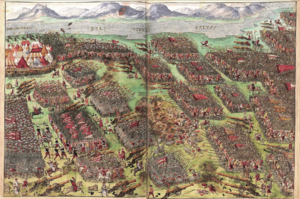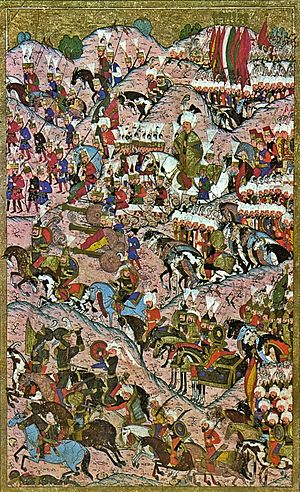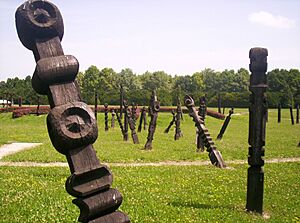Battle of Mohács facts for kids
Quick facts for kids Battle of Mohács |
|||||||
|---|---|---|---|---|---|---|---|
| Part of the Ottoman wars in Europe and Ottoman–Hungarian wars | |||||||
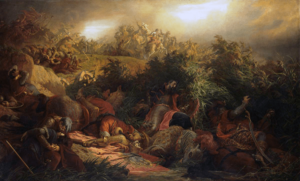 Battle of Mohacs by Bertalan Szekely |
|||||||
|
|||||||
| Belligerents | |||||||
| Kingdom of Hungary Kingdom of Croatia Serbian Despotate Crown of Bohemia Holy Roman Empire Duchy of Bavaria Papal States Kingdom of Poland Hungarian Slovenes |
|||||||
| Commanders and leaders | |||||||
| Suleiman I Pargalı Ibrahim Pasha Malkoçoğlu Bali Bey Gazi Hüsrev Bey Behram Pasha |
Louis II of Hungary † Pál Tomori † György Zápolya † Stephen VII Báthory Pavle Bakić Radič Božić |
||||||
| Strength | |||||||
|
50,000
|
45,000-50,000
|
||||||
| Casualties and losses | |||||||
| ~1,500–2,000 | 14,000, 20,000 or 24,000 killed 2,000 prisoners executed 10,000 captured |
||||||
The Battle of Mohács was a major battle fought on August 29, 1526. It took place near Mohács, in the Kingdom of Hungary. The battle was between the forces of Hungary and its allies, led by King Louis II, and the powerful Ottoman Empire, led by Sultan Suleiman the Magnificent.
The Ottomans won a huge victory. This battle changed the history of Hungary for centuries. It led to Hungary being divided among the Ottoman Empire, the Habsburg monarchy, and the Principality of Transylvania. King Louis II died while trying to escape the battle. His death ended the Jagiellonian dynasty in Hungary and Bohemia. The claims to the throne then passed to the House of Habsburg.
During the battle, the Ottomans used a new way of firing their guns. Soldiers would kneel or stand in rows and shoot one row at a time. This was one of the first times volley fire with matchlocks was used by their elite soldiers, the Janissaries.
Contents
Why Did the Battle of Mohács Happen?
The Battle of Mohács didn't happen out of nowhere. Many events led up to this important clash.
How Did Hungary's Power Decline?
After King Matthias Corvinus died in 1490, Hungarian nobles wanted a weaker king. They chose Vladislaus, who was known for agreeing to everything. He gave away much of the royal land and money to the nobles. This made the king's power much weaker.
The government faced serious money problems. Nobles paid much less in taxes, which hurt the country's ability to defend itself. The king became a "prisoner" of the nobles, unable to make decisions without them.
The strong army of Matthias Corvinus was disbanded by the nobles. Border guards and castle soldiers were not paid, and fortresses fell apart. Hungary's role in Europe became smaller, and its government was unstable. The arrival of Protestantism also caused more problems within the country.
In 1514, King Vladislaus II faced a big peasant uprising led by György Dózsa. Nobles, led by John Zápolya, crushed this rebellion very harshly. This made the Hungarian people less united. This lack of unity made it easier for the Ottoman invasion in 1526.
Attempts to Defend Against the Ottomans
King Louis II of Hungary married Mary of Habsburg in 1522. The Ottomans saw this marriage as a threat to their power in the Balkans. Sultan Suleiman I offered peace to Hungary, but Louis refused. He might have thought war was a better option, as the Ottomans often raided Hungarian lands even during peacetime.
Hungary and Croatia often asked Holy Roman Emperor Maximilian I for help. But help was slow to arrive. Later, Archduke Ferdinand (who became Emperor Ferdinand I) tried to help his brother-in-law, King Louis. He sent 2,000 German soldiers. However, this aid didn't fully solve the problem.
Some historians believe that King Louis was not strong enough as a leader. Queen Mary was more decisive, but her foreign advisors caused distrust among the Hungarians.
Europe's Situation and the French-Ottoman Alliance
In Europe, especially Germany, there were other big problems. Powerful families like the Fuggers controlled much of the money. They even controlled how the Catholic Church sold indulgences (pardons for sins). This led to a huge scandal and social unrest.
After 1517, the Reformation started by Martin Luther divided Europe. There was also the German Peasants' War from 1524 to 1526. This war involved many people and caused over 100,000 deaths.
Between 1521 and 1526, Western European powers were busy with the Italian wars. France, led by King Francis I of France, sought allies against Holy Roman Emperor Charles V. France tried to ally with Poland and Hungary, but they refused.
Francis I was defeated and captured by Charles V's troops in 1525. After being held prisoner, Francis I was forced to sign a treaty. To get help against Charles V, Francis I then made a special alliance with Sultan Suleiman the Magnificent. This Franco-Ottoman alliance lasted for about 300 years.
Francis asked Suleiman to attack the Holy Roman Empire. The path from Turkey to the Holy Roman Empire went through Hungary. This request fit well with Suleiman's own goals in Europe. It gave him a reason to attack Hungary in 1526, leading to the Battle of Mohács.
When war was declared, King Louis II asked other European leaders for help. Only King Henry VIII of England offered aid, but it arrived too late. The Pope offered money. Charles V and Ferdinand Habsburg, Louis's brother-in-law, did not send troops. Their armies were busy fighting in Italy.
Preparing for Battle
The Hungarians had tried to stop the Ottoman Empire from expanding. But in 1521, the Turks captured Nándorfehérvár (now Belgrade, Serbia). This was Hungary's strongest fortress on the Danube River. Its loss left much of southern Hungary open to attack.
The loss of Nándorfehérvár caused great fear in Hungary. A large royal army of 60,000 men was gathered, but it was too slow and didn't bring enough food. The army broke apart due to hunger and disease.
In 1523, Archbishop Pál Tomori, a brave priest and soldier, became captain of Southern Hungary. He used his own church money to repair Hungary's defenses. But fortresses like Pétervárad still fell to the Turks in July 1526. This was because there were not enough soldiers to guard them.
The Ottoman army, led by Sultan Suleiman, set out from Constantinople on April 16, 1526. The Danube River was a key route for the Ottoman army. It was clear they would follow the river. For about 400 kilometers along the Danube, there were no Hungarian forts or towns to stop them.
Hungarian nobles did not fully understand the danger. They were slow to send troops to their king. Eventually, the Hungarian forces gathered into three main groups. One was the Transylvanian army under John Zápolya, with 8,000 to 13,000 men. The main army was led by King Louis himself, with many soldiers from Spain, Germany, Czechia, and Serbia. A smaller force of about 5,000 men was led by the Croatian count Christoph Frankopan.
The Ottomans had a huge number of cannons, about 300. The Hungarians had only 85 cannons. Even so, this was more than many other European armies had at the time. The Ottoman Empire had about 15,000 to 16,000 professional soldiers. For big campaigns, Suleiman could gather an army of 50,000 to 60,000 men.
The Ottomans bought many of their guns (arquebuses) from Hungarian and Venetian gunsmiths. This was such a problem that Hungary passed a law in 1525 to stop the export of these weapons to the Ottomans.
The Hungarian infantry also had many arquebuses, giving them strong firepower. Both armies faced a challenge: they couldn't move their heavy guns easily. They could only use them well from a defensive position. The main question was who could force the other side to attack first.
The Hungarian army included 3,000 armored knights, 1,000 royal bodyguards, 4,500 light cavalry (mostly Serbian hussars), and 6,700 Hungarian infantry. There were also 5,300 Papal infantry (mostly German soldiers) and 1,500 Polish infantry.
The geography of the area meant Hungarians didn't know the Ottomans' exact plan until they crossed the Balkan Mountains. By then, the Transylvanian and Croatian forces were too far from Buda. King Louis preferred to retreat and give up land rather than fight a direct battle. However, the Hungarian war council decided to fight near Mohács. This was an open, uneven plain with some swamps. This was a big mistake, as they didn't wait for reinforcements.
There was also a lack of clear communication between King Louis and his brother-in-law, Archduke Ferdinand. Ferdinand didn't realize how urgent the situation was. Louis and his court also failed to tell Ferdinand they had decided to fight a decisive battle at Mohács. Some nobles convinced the king to fight immediately, even though the Ottomans had more soldiers. Ferdinand was busy with other problems in his own lands.
The Ottomans marched towards Mohács almost without opposition. They captured several towns and crossed rivers. At Mohács, the Hungarian army had about 25,000 to 30,000 soldiers. The only outside help was 1,500 Polish soldiers. The Ottoman army was much larger, perhaps 50,000 men. Some historians say it was even 100,000.
The Hungarian army tried to use the land to their advantage. They hoped to fight the Ottoman army in smaller parts. Their soldiers were well-rested, while the Turks had just finished a long march in hot weather.
The Battle Itself
The Hungarian army set up in two lines. The first line had mercenary foot soldiers and cannons in the middle, with most of the cavalry on the sides. The second line was a mix of drafted foot soldiers and cavalry. The Ottoman army was more modern. It was built around cannons and elite musket-armed Janissaries. The rest of the Ottoman army included feudal cavalry and soldiers from the Balkans.
When the first Ottoman troops arrived, Hungarian soldiers led by Pál Tomori attacked them. This attack caused a lot of confusion among the Ottoman irregular troops. But as the Hungarians pushed forward, the Ottomans brought in their regular soldiers from reserves.
At one point, the Hungarian attack went so far that Sultan Suleiman was in danger from Hungarian bullets. But the strong Ottoman regular soldiers and a timely charge by the Janissaries overwhelmed the attackers. This was especially true on the Hungarian left side. The Hungarians suffered heavy losses from the skilled Turkish cannons and musket fire.
The Ottoman cavalry surrounded the Hungarian army in a pincer movement. In the center, the Hungarian heavy knights and foot soldiers were pushed back. They suffered many casualties, especially from the well-placed Ottoman cannons and trained Janissary musketeers. The Hungarians could not hold their positions. Those who didn't run away were surrounded and killed or captured.
Almost the entire Hungarian royal army was destroyed in about two hours. During the retreat, the 20-year-old King Louis II died. He fell off his horse into a steep stream. Because of his heavy armor, he couldn't get up and drowned. Sultan Suleiman the Magnificent was sad about the young king's death. He reportedly said he didn't wish for Louis to die so young.
The battle was a disaster for the Hungarians. Their lines advanced into heavy fire and flank attacks. They fell into the same trap that John Hunyadi had often used against the Ottomans. Besides the king, about 1,000 other Hungarian nobles and leaders were killed. It is believed that more than 14,000 Hungarian soldiers died in the battle.
Suleiman couldn't believe that this small army was all that Hungary could gather. He waited at Mohács for a few days before moving carefully towards Buda. On August 31, 2,000 Hungarian prisoners were killed on the Sultan's orders.
What Happened After Mohács?
The victory did not give the Ottomans the full control they wanted right away. Buda, the Hungarian capital, was left undefended. Only French and Venetian ambassadors were there to congratulate the Sultan. The Ottomans entered Buda, looted the castle, and then left. It wasn't until 1541 that the Ottomans finally captured and occupied Buda.
The Battle of Mohács effectively ended the independent Kingdom of Hungary as a unified country. In the political chaos, the divided Hungarian nobles chose two kings at the same time. They elected John Zápolya in 1526 and Ferdinand of Austria in 1527. Ferdinand was Louis's brother-in-law and claimed the throne through a treaty.
Bohemia became part of the Habsburgs' lands. The Habsburgs also controlled the northern and western parts of Hungary and parts of Croatia. The Ottomans held central Hungary and had power over the semi-independent Transylvania. This division made Hungarians continue to fight against Ottoman rule for another 70 years.
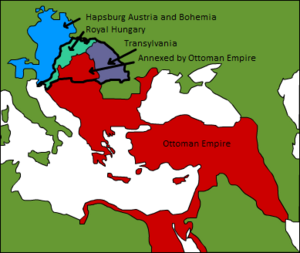
The Habsburg rulers in Austria needed Hungary's economic power for their wars against the Ottomans. During these wars, the size of the Kingdom of Hungary shrank by about 60%. Despite losing land and people, the smaller, war-torn Royal Hungary was still very important for money in the late 1500s. It was Ferdinand's biggest source of income.
The constant warfare required many Ottoman soldiers and resources. This was a drain on their empire. Crusader armies tried to capture Buda several times in the 1500s. Sultan Suleiman himself died in Hungary during the Battle of Szigetvár in 1566. The Ottomans also failed twice to capture Eger, which didn't fall until 1596. The Turks could not conquer the northern and western parts of Hungary, which remained under Habsburg rule.
Legacy of Mohács
Many Hungarians see Mohács as a major turning point in their country's history. It is a national trauma that people still remember. To show how bad something is, Hungarians sometimes say: "more was lost at Mohács" (Hungarian: Több is veszett Mohácsnál). Hungarians view Mohács as the end of Hungary as a strong, independent European nation.
While Mohács was a huge loss, it was the events that followed that truly ended Hungary's full independence. The next 200 years saw almost constant fighting between the Habsburg and Ottoman empires. This turned Hungary into a constant battlefield. Its lands were split into three parts. The countryside was often destroyed by armies, which also harmed the population. Hungary only regained its old borders in the 1800s. It became fully independent from Habsburg rule after World War I.
The battlefield, near the village of Sátorhely, became an official national historical memorial site in 1976. This was on the 450th anniversary of the battle. A new reception hall and exhibition building were completed in 2011.
See also
- The Ottomans: Europe's Muslim Emperors


